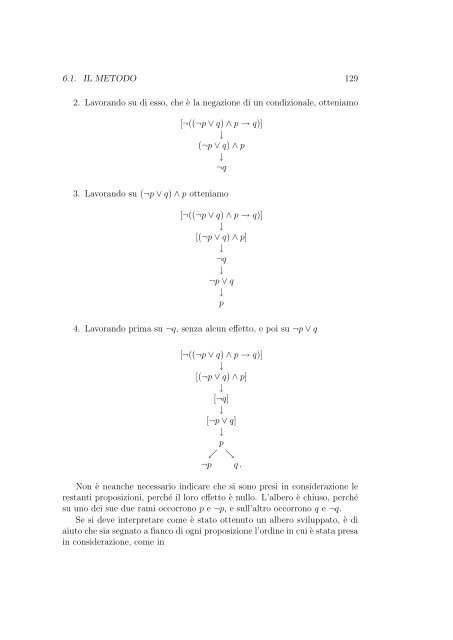Logica Matematica Corso di Laurea in Informatica ... - Mbox.dmi.unict.it
Logica Matematica Corso di Laurea in Informatica ... - Mbox.dmi.unict.it
Logica Matematica Corso di Laurea in Informatica ... - Mbox.dmi.unict.it
You also want an ePaper? Increase the reach of your titles
YUMPU automatically turns print PDFs into web optimized ePapers that Google loves.
6.1. IL METODO 129<br />
2. Lavorando su <strong>di</strong> esso, che è la negazione <strong>di</strong> un con<strong>di</strong>zionale, otteniamo<br />
[¬((¬p ∨ q) ∧ p → q)]<br />
↓<br />
(¬p ∨ q) ∧ p<br />
↓<br />
¬q<br />
3. Lavorando su (¬p ∨ q) ∧ p otteniamo<br />
[¬((¬p ∨ q) ∧ p → q)]<br />
↓<br />
[(¬p ∨ q) ∧ p]<br />
↓<br />
¬q<br />
↓<br />
¬p ∨ q<br />
↓<br />
p<br />
4. Lavorando prima su ¬q, senza alcun effetto, e poi su ¬p ∨ q<br />
[¬((¬p ∨ q) ∧ p → q)]<br />
↓<br />
[(¬p ∨ q) ∧ p]<br />
↓<br />
[¬q]<br />
↓<br />
[¬p ∨ q]<br />
↓<br />
p<br />
↙ ↘<br />
¬p q .<br />
Non è neanche necessario <strong>in</strong><strong>di</strong>care che si sono presi <strong>in</strong> considerazione le<br />
restanti proposizioni, perché il loro effetto è nullo. L’albero è chiuso, perché<br />
su uno dei sue due rami occorrono p e ¬p, e sull’altro occorrono q e ¬q.<br />
Se si deve <strong>in</strong>terpretare come è stato ottenuto un albero sviluppato, è <strong>di</strong><br />
aiuto che sia segnato a fianco <strong>di</strong> ogni proposizione l’or<strong>di</strong>ne <strong>in</strong> cui è stata presa<br />
<strong>in</strong> considerazione, come <strong>in</strong>




![Introduzione ai sistemi Wiki [PDF] - Mbox.dmi.unict.it](https://img.yumpu.com/16413205/1/184x260/introduzione-ai-sistemi-wiki-pdf-mboxdmiunictit.jpg?quality=85)











